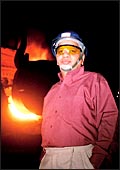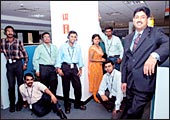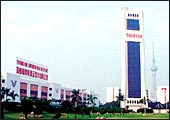|
Even
in ordinary times, putting together a list such as this one is
a devilishly difficult task. After all, there's something or the
other happening at every company. So, how do you decide which
to drop and which to keep? And in these extraordinary times, zeroing
in on 20 companies to watch is a million times harder. The economy
is booming, companies large and small are betting big on acquisitions,
new products, new markets, and new strategies. Private equity
and venture capital is flowing into little-known firms, start-ups
are mushrooming across sectors, and interesting new technologies
are emerging both online and offline. Therefore, to bring you
a list of 20 companies to keep an eye on next year, BT's reporters
and editors across the country spoke to a variety of experts,
including D-street analysts, fund managers, investment bankers,
private equity and venture investors, bankers, and senior executives.
As you can imagine, the list we ended
up with comprised more than just 20 companies. To whittle it down
to the required number, we employed a few filters: One, the company
needed to be most popularly cited by our experts; Two, the list
needed to be well balanced in terms of the nature and size of
companies; Three, the company should not have featured in our
listing the previous year. However, we had to make an exception
in the case of two companies-Tata Steel and Maruti Udyog-simply
because they seemed to be on everyone's to-watch list. For good
reason. Next year, Tata Steel will begin putting India Inc.'s
biggest overseas acquisition, Corus, to work; next year, too,
Maruti, having once retreated from the diesel car market, will
again seek to displace Tata Motors' Indica as the diesel car of
choice. The others also have a lot going for themselves. Turn
the page to find out.
ABB
Stepping Up the India Charge
 |
| ABB Indo's Uppal: The investments will
continue no matter what |
It has grown
for each of the past 24 quarters, upped revenues from Rs 1,000
crore to around Rs 4,000 crore in that time, and boosted profits
from Rs 65 crore to analysts' estimate of Rs 290 crore this year.
Is it possible then, that there's more steam left in ABB India,
subsidiary of the Geneva-based power-automation-engineering giant?
Yes, say analysts, because with the economy on a roll and investment
in infrastructure and industrial projects gathering speed, ABB
is plugged into a multi-billion-dollar opportunity. According
to estimates, there are power and industrial projects in the pipeline
worth several hundreds of crores. No wonder, ABB's order book
is brimming over, with contracts worth Rs 4,211 crore over the
next several years, and folks in Geneva have declared India a
"prime focus" country. In response, the engineering
giant is ramping up manufacturing capacities in the country. By
the middle of 2007, it would have completed a $100-million (Rs
450 crore) investment programme that will not just boost throughput,
but increase the breadth and depth of portfolio offerings in the
market place. Says Ravi Uppal, Vice Chairman & MD, ABB India:
"There is no cap on capex. We will continue to invest whatever
it takes." Apparently, investors have no issues with the
strategy. ABB India's stock price has almost doubled to Rs 3,490
in the last one year alone and trades at a p-e multiple of 51.
-Venkatesha Babu
 |
| Adlab's Shetty: Plans to grow his 50-screen
multiplex business fourfold |
ADLABS
The Picture Gets Bigger and Better
Like in every
good bollywood movie, the Adlabs' story has had a happy twist.
"If you ask me whether I knew the business would assume this
scale before July last year, the answer is no," says Manmohan
Shetty, Chairman & MD, Adlabs. June 2005 was when Anil Ambani's
Reliance Capital bought a majority stake in Adlabs Films. "The
money, new talent, and management have helped create a media house
present in every sphere of entertainment business," says
Shetty, who runs a movies-to-film processing-to-multiplex group.
How life has changed is evident not just from its Q2 results (revenues
up 115 per cent to Rs 50 crore) but also investment plans. In
the film production business, from investing Rs 15-20 crore a
year hitherto, the company is now investing Rs 60-70 crore. It
has struck a multi-film, co-production deal with Ashok Amritraj's
Hyde Park Entertainment, set up a new animation arm that is already
working on a 3D film called Superstar, and plans to invest Rs
40-50 crore in film distribution. Shetty is also looking to grow
his 50-screen multiplex business fourfold, and scale up television
content production following the purchase of a majority stake
in Siddhartha Basu's Synergy Communication. Plus, "the demerger
of the radio business is expected to unlock substantial shareholder
value," says Chiraj Negandhi, an analyst with Enam.
-Shivani Lath
AIRCEL
New Owner, New Plans
 |
| Aircel's Kini: Sets his eyes nationwide |
My mandate is
to make Aircel a national player from a regional player,"
says Jagdish Kini, also answering the question why the erstwhile
C. Sivasankaran-owned mobile services company made it to our list
this year. As you might know, Malaysia's Maxis group (and Apollo)
acquired Aircel in January 2006 and has since obtained licences
to operate in nine circles. It has applied for 14 more as part
of its plan to offer services across India. Maxis' proposed investment
in cellular roll-out, 3G spectrum and WiMax is $3 billion, or
Rs 13,500 crore. Aircel, which has 3.8 million subscribers mainly
in Tamil Nadu, is betting on WiMax, or last-mile, wide-area wireless
broadband (It WiMaxed Baramati with Intel). Neither the investments
in nor the revenues from WiMax are expected to be significant,
yet "Aircel hopes to get a first-mover advantage," says
Ram Shinde, Aircel's Head (Business Solutions).
-Nitya Varadarajan
 |
| Shifting focus to smart cards: Yes,
that's the Bartronics boss |
BARTRONICS
Coming Soon to Every Pack in Your Shopping
Bag
Mumbai-based
Karvy Stockbroking has been quietly accumulating the Bartronics
stock since it was at Rs 55 about five months ago. And Ambareesh
Baliga, the firm's Vice President, has no intentions of taking
his eye off the stock, which now trades at over Rs 100. "It's
one of the best proxy plays available in the organised retail
space," says Baliga. What does the Rs 30-crore (at the end
of March 2006) Bartronics do? The Hyderabad-based company makes
a wide variety of data capturing equipment such as barcode scanners,
terminals and printers, smart card readers, and RFID tags. Interestingly
enough, retail is currently a small part of Bartronics' business,
"but we believe it will definitely constitute a major portion
of our business in the next two years," says MD & CEO
Sudhir Rao. Accordingly, Bartronics is shifting focus to smart
cards and point of sale (pos) systems, and hopes to become a Rs
200-250 crore company in another two years. RFID-based solutions
fetched half of Bartronics' revenues in the first half of current
fiscal. But Rao is betting big: "We are working towards a
Rs 1,000-crore sales target," he says. Baliga must be smiling.
-Mahesh Nayak
BHEL
Power-packed PSU
 |
| BHEL's Puri: India must acquire technology |
How's this for
growth potential? India plans to add 674,000 mw of power capacity
over the next 25 years, and there's only one end-to-end domestic
manufacturer of power plants in the country: BHEL. "The company
currently has limitless order intake and earnings visibility,"
quips Satyam Aggarwal, a power industry analyst at Motilal Oswal
Securities. "There were some concerns over BHEL lacking supercritical
technology (requiring a plant of at least 4,000 mw with constituent
units of 800 mw or more), but those issues seem to have been sorted
out," he adds. To some extent, yes. BHEL's Chairman &
Managing Director, Ashok K. Puri, for instance, has struck deals
with France's Alstom (for boilers) and Siemens (turbine generator
sets) for supercritical plants for ultra mega power projects.
More importantly, he's lined up Rs 1,000 crore for acquisitions
abroad. "India must learn from the Dabhol debacle and acquire
technology. Otherwise, we could be investing billions on buying
equipment and not know how to run them," he says. BHEL's
topline surged 41 per cent last year to Rs 14,525 crore, and this
year it may cross Rs 20,000 crore.
-Kapil Bajaj
 |
| BillDesk's Kaushal: From Arthur Andersen
to India's leading electronic payment gateway |
BillDesk
They are Killing the Bill Queues
In early 2000,
three Arthur Andersen executives-M.N. Srinivasu, Ajay Kaushal,
and Karthik Ganapathy-quit their cushy jobs to launch a start-up
out of a small house on suburban Mumbai's Carter Road. The trio
thought they had a great payment management service idea (read:
third-party bill collection) and, hence, kicked off IndiaIdeas.
And, boy, were they right. Today, as many as 25 banks (Citi, SBI,
HDFC Bank, among others) and more than 100 companies (including
Hutch, Reliance Energy, Tata AIG) are part of IndiaIdeas' electronic
payment gateway, BillDesk. "We are the largest player with
over a million bills processed every month," says Kaushal.
BillDesk already has 240 employees across 30 cities, but has plans
of ramping up operations. "There is a huge potential. The
share of online billing, which is less than 2 per cent, is expected
to go up to 6-8 per cent in the next three to five years,"
says Kaushal. There are plenty of believers in BillDesk's business
model. In June this year, SBI and us-based venture capital firm
Clearstone Ventures invested $7.5 million (Rs 34 crore) in the
company. So, expect an IPO a few years down the line.
-Anand Adhikari
DLF
The IPO is in Sight Again
 |
| DLF: Its troubled IPO issue could be
resolved shortly |
The Delhi-based
real estate giant DLF's initial public offering (IPO) may well
have been a top contender for the most talked of non-event of
the year. The company had been planning to roll out one of India's
biggest-and realty's biggest-IPOs aimed at raising more than Rs
10,000 crore, until its minority shareholders cried foul and forced
SEBI to show the red flag. When BT went to press, DLF, which had
been valued between Rs 77,200-85,300 crore, had an extra-ordinary
general body meeting coming up on November 14 to settle the issue.
That means the IPO is in sight again. "If the minority shareholder
issue is resolved, then the public offer could hit the market
during the January-March quarter," confirms Rajeev Talwar,
DLF group's Executive Director. The IPO, however, is not the only
reason why DLF has made it to our list. The other reason is, of
course, the real estate boom. The Indian real estate market estimated
at $40-45 billion (Rs 1.8-2 lakh crore) is expected to grow at
20 per cent compounded annual growth rate over the next five years
or so, according to UBS Investment Research. And DLF has plans
for everything from houses to commercial buildings to SEZs. "Eventually
each of (these) verticals should become large enough to become
separate companies," says Talwar. Now, that is some ambition.
-Shalini S. Dagar
 |
| All smiles and why not? Prasad (L) &
Satish Reddy, MD |
Dr Reddy's
The Recipe is Working
It's possibly
the highest-ever quarterly sales announced by an Indian drug company.
For the second quarter of this year, Dr Reddy's Labs announced
a year-on-year 245 per cent growth in topline to Rs 2,004 crore
and a 214 per cent jump in net profits to Rs 280 crore. If all
goes well, Dr Reddy's will be pushing a billion dollars in revenues
before 2007 is rung out. "The acquisitions added a lot of
firepower to the business coupled with a few upsides," says
company CEO, G.V. Prasad. The new acquisitions such as betapharm
fetched a fifth of the Q2 revenues, and international sales made
up an impressive 88 per cent versus 61 per cent same period last
year. There are two other reasons to watch Dr Reddy's: One, its
generic version of GSK's $1-billion drug Zofran (an anti-emetic),
Prasad says, is likely to get an approval. That could mean Rs
225 crore in profits during the exclusivity period. Two, one of
its new molecules (balaglitazone) for treatment of diabetes is
expected to enter phase III of clinical trials over the next six
months, making Dr Reddy's India's first company to have a phase
III asset. Also, Prasad isn't ruling out more acquisitions abroad.
-E. Kumar Sharma
Ginger
Smart Basics for Road Warriors
 |
| Ginger, Bangalore: This no-frills budget
hotel has been an instant hit |
It was an idea
borrowed straight out of C.K. Prahalad's bestseller on bottom
of the pyramid (bop) marketing. No surprises, then, that Indian
Hotels' budget hotel subsidiary, Roots Corporation, is pleased
as punch with the results. Its no-frills budget hotel Ginger,
launched in June 2004, has been a roaring success. All Ginger
properties (Bangalore, Mysore, Haridwar, Pune, Trivandrum and
Bhubaneshwar) have a simple layout and design with around 100
rooms in each property. Since land price is a key determinant
of the eventual tariff, most of these hotels are located on the
outskirts or at least outside the central business district, where
prices tend to be more reasonable. There's no room service or
travel desk or swimming pool, but the rooms have everything a
budget-conscious business traveler would need, including Wi-Fi.
Also, there's a closed circuit camera in the lobby of all Ginger
hotels for greater security. There are just two types of rooms,
single bed (180 sq. ft) and double bed (220 sq. ft) with transparent
prices of Rs 999 and Rs 1,199, respectively that are uniform across
properties. "We call our model smart basics, which means
good quality at affordable prices," says Prabhat Pani, CEO,
Roots. By March 2008, Ginger hopes to be in 30 cities. Road warriors,
rejoice.
-Venkatesha Babu
 |
| Coming soon: New-look Delhi & Hyderabad
airports, courtesy GMR |
GMR Infrastructure
The Long Road from Jute to Airports
If the Hyderabad
airport gets up and running by April 2008 and Delhi too sports
a spiffy new one by 2010, air travellers will have one Bangalore-based
company to thank: GMR Infrastructure. The Hyderabad airport is
a Rs 2,284-crore project, while Delhi's has a cost of Rs 7,000
crore. That should make GMR one of the biggest infrastructure
developers. For a company that entered infrastructure only in
the 90s, GMR has been able to bag some big projects. The airports
apart, GMR has landed a number of road projects under the Golden
Quadrilateral project. Focussing on project development, as opposed
to mere execution, has enabled GMR, which once was in the jute
business, to build assets worth Rs 15,000 crore from Rs 900 crore
in 1999.
GMR executives say that the group has a healthy
blend of fixed and volume-driven revenues. Investors in the newly-ipoed
company have nothing to complain about. The stock is trading 70
per cent above the issue price of Rs 210. "As India's infrastructure
needs explode, GMR Group will strive to meet them," says
Chairman G.M. Rao. Investors expect as much.
-Venkatesha Babu
Idea Cellular
Its Time Has Come
 |
| Idea Cellular's Aga: Man to watch |
For Sanjeev Aga,
the last several months have been incredibly busy. After the Tatas
sold their stake in Idea to the Aditya Birla Group, the cellular
services provider went on an overdrive and launched operations
in three new circles (Rajasthan, Himachal Pradesh, and Uttar Pradesh-East),
taking the tally to 11. Between March and September this year,
the subscriber base jumped 54 per cent, and first half revenues
rose 38 per cent to Rs 1,906 crore and net profit by 160 per cent
to Rs 192 crore. "We are in a very strong position in the
circles we operate and our renewed focus will help us to power
ahead," states Aga, who has taken over as Idea Cellular's
Managing Director from his earlier assignment as MD of Aditya
Birla Nuvo.
The big story for Idea is yet to unfold,
though. With a pan-India launch on the anvil and licence awaited
for the National Long Distance Service (NLD) service, growth-and
a place alongside Bharti, Hutch and Reliance Infocomm-appears
inevitable. Then, there's the IPO story. With Idea already valued
at Rs 12,000 crore following private equity investment from Providence
Partners and ChrysCapital and its footprint growing, the company
can only get more valuable. "To us, nothing is more important
than Idea being a top-notch company. We want it to be a class
act," says Aga in modesty. A good idea, too.
-Krishna Gopalan
 |
| Kale's Jain: Looking to leverage the
company's position to cater to the entire travel industry |
Kale Consultants
Reprogrammed, But Keeping Its Fingers Crossed
It's possibly
the only reinvention of its kind in the Indian it industry and
if it works, it may well inspire several other small companies
to find their own niches. Founded in 1986, Kale continued to operate
in a number of industry verticals but without achieving viable
scale in any of them. Starting 2001, the Pune-based company began
spinning out all the verticals (banking, generic software, and
healthcare) and selling them to willing buyers. In October 2004,
it acquired Cognosys, a travel solutions company, and merged it
with itself. "We focussed on the airline vertical as we've
had some global exposure there," says Vipul Jain, CEO &
MD, Kale. With the result, the Rs 73-crore firm has emerged as
a focussed airline software and BPO player, offering outsourced
services to airlines that include passenger revenue accounting,
cargo management and travel solutions for travel companies. Over
the years, Kale has shifted to a 'per transaction' model from
the "licensing model' it followed earlier. "We have
the foundation. Now we are looking to leverage our position to
cater to the entire travel industry," says Jain. Investors
aren't yet convinced, since the stock has stayed stoically between
Rs 90 and Rs 100 for a year now. Just the same, it's a reinvention
worth watching.
-Shaleen Agrawal
Larsen & Toubro
A Makeover on Many Fronts
 |
| L&T: All set to become bigger and more
diversified |
Not too far in
the future, Larsen & Toubro may look very different than what
it does today. While its flagship engineering and construction
business still fetches 70 per cent of the revenues, Chairman &
Managing Director A.M. Naik seems determined to turn the conglomerate
into a bigger and even more diversified entity. Among L&T's
new forays are the ones into shipbuilding, defence equipment,
and nuclear power. Simultaneously, Naik is pushing L&T into
newer markets overseas in the core business. For instance, West
Asia and China, he says, will be important makets. "Gulf
(alone) will bring in $1 billion (Rs 4,500 crore) in revenues
next year," says Naik. In power, L&T Power Development
is moving from merely building power plants to running and maintaining
them, thus creating steadier revenues. L&T Infotech, the IT
arm, is planning to add 3,000 employees to the existing 8,000
by March 2008. Some time soon in the future, Naik expects 60 per
cent of L&T's revenues to come from projects, 30 per cent
from manufacturing, and 10 per cent from services, against 75,
20, and 5 per cent, respectively, at present. "Infrastructure
is a long-term play and the most demanding one," he says.
And few Indian companies can claim to have the sort of execution
skills that L&T has.
-Shaleen Agrawal
 |
| Maruti: Khattar has a bolder diesel
plan this time around |
Maruti
Driving (Back) Into Diesel
As a rule, a
company never gets to be on our "to watch" list for
two years in a row. If we are breaking that rule for Maruti, it's
for good reason. Next year is when the market leader will ride
back into the diesel segment with a vengeance, putting pressure
on Tata Motors' small car, the Indica. This will mark Marurti's
second foray into diesel. The first attempt, made on the back
of Zen diesel, didn't quite work. This time around, Maruti is
dropping a 1.3-litre diesel engine into the hot selling small
car, Swift. Between the first and second attempt, Maruti has increased
car making capacity from 4 to 6 lakh per annum, and also set up
a diesel engine plant at Manesar near Gurgaon with an annual capacity
of 3 lakh engines. "I look forward to 2007 with cautious
optimism. There has been strong growth in this fiscal so far.
This is a decisive year when many of our new projects go on stream,"
says Maruti's MD, Jagdish Khattar. The small diesel car segment
accounts for 13 per cent of the car market. Expect the fight between
Maruti and Tata Motors to be bruising.
-Kushan Mitra
Praj Industries
Betting on Biofuels
 |
| On Chaudhari's mind: A Rs 1,000-crore
company by 2010 |
Be it the US
or India, venture investor Vinod Khosla is a tough cookie. So,
when Khosla, a former partner at Kleiner Perkins, decided to pick
up a 10 per cent stake in a little-known Pune-based company, Praj
Industries, people sat up to take note. Some years ago, India's
stock market bull, Rakesh Jhunjhunwala, had also picked up an
identical stake in Praj. What's special about the Rs 267-crore
company? To put it simply, ethanol. Praj, promoted by IIT alumnus
Pramod Chaudhari, specialises in setting up ethanol machinery
and has executed projects across five continents. "We are
the only company out of India offering end-to-end solutions in
ethanol," says the 57-year-old Chaudhari. Over the last 10
months, Praj has received an equal number of export orders, especially
from the US. Chaudhari's target: Make Praj a Rs 1,000-crore company
by 2010. If ethanol-blended fuel takes off in the future, Praj
will soar in tow.
-Anand Adhikari
 |
| Reliance Fresh store in Hyderabad: Just
a curtain-raiser |
Reliance Retail
The Game Changer
Back in may
this year, reliance fresh was just a gleam in the eye of executives
at Reliance Retail. By the end of October, they had launched the
first store on Hyderabad's Banjara Hills. That's just one reason
why Reliance is like an elephant in India's organised retail industry.
The other is, of course, the fact that no one else has the kind
of investment plans hat Reliance has: Rs 25,000 crore across formats
and across categories, ranging from produce to groceries to footwear
to consumer durables, and vertically integrated supply chain.
In 2007 (and beyond) more of Reliance's retail strategy will unfold,
potentially rattling existing players. "The end goal,"
says Raghu Pillai, President and Chief Executive (Operations and
Strategy), Reliance Retail, "is clear and that is to cover
across all formats, 100 million sq. ft of retail space and have
a topline of Rs 1 lakh crore by 2010-11." Seems patently
Reliance.
-E. Kumar Sharma
Shriram Transport Finance
Trucking On All Over
 |
| Sridhar: He's hitched his stars to the
truck financing business |
Financing commercial
vehicles isn't a terribly exciting business to be in. Three-fourths
of the fleet owners who get their trucks financed own less than
five trucks. Most of them are semi-literate, but that's not the
only reason why they aren't the easiest of customers to handle.
Yet, if private equity investors such as Citi, Newbridge and ChrysCapital
have been falling over each other to get a piece of Chennai-based
Shriram Transport Finance, it's because the company knows how
to make the business throw up oodles of cash. With Rs 9,000 crore
in assets, Shriram churns out net interest margins of 9 per cent
and logged a net profit of Rs 140 crore last year. And according
to a study commissioned by Shriram, the opportunity for truck
financing is set to boom. The study estimates a minimum potential
demand of Rs 45,000-50,000 crore over the next 10 years. Of that,
financing pre-owned trucks less than four years old and trucks
between five and 10 years old, segments where Shriram dominates,
will account for Rs 40,000 crore. Besides, the firm has also started
financing new trucks, where it already has a 10 per cent share.
"All the new trucks that are bought will come to us for modernisation
funds once they are four years old," says the company's Managing
Director R. Sridhar. By March next year, the company will grow
assets to Rs 10,500 crore. Moral of the story: Businesses needn't
be exciting; they only need to be profitable.
-Nitya Varadarajan
 |
| Muthuraman: It's all about synergies |
Tata Steel
Now Comes the Tough Part
At Bombay House,
the Tata Group headquarters, celebrations over the $8-billion
(Rs 36,800 crore) Corus acquisition are long over. B. Muthuraman,
Tata Steel's Managing Director, is already hunkering down for
hard work next year. "For us, the most important thing is
to complete the deal in time (by January 2007) and then being
prepared for the synergies to be worked out thereafter,"
says the man about India Inc.'s biggest overseas acquisition so
far. What Tata Steel makes of Corus-a much larger steel manufacturer,
but much less efficient than the Indian buyer-will be important
not just for the Tatas, but for Indian industry in general. After
all, Tata Steel will be raising $6 billion (Rs 27,600 crore) in
debt to fund the purchase, and how it handles a downturn-if any
comes along-will be keenly watched by analysts and others. "We
will be sharing our best practices. There will be operational
synergies, market synergies, synergies on logistics management
and on so many other areas," says Muthuraman. One way or
another, it has all the makings of a B-school case study.
-Ritwik Mukherjee
TransWork
New Worlds to Conquer
 |
| Kanwar (R) and his team: Global ambitions |
A year ago, transworks,
the Aditya Birla group's BPO arm, was just one of the 200-odd
BPO companies in India. But on July 3 this year, the Mumbai-headquartered
operator changed all that with just one deal when it acquired
the Santiago, Chile-based Minacs for $125 million (Rs 558 crore
then) and in the process shot up the bpo rankings to #2. From
being a company with revenues of Rs 164 crore, TransWorks metamorphosed
to a Rs 1,350-crore vendor. "With the acquisition of Minacs,
the company (which has more than doubled the headcount to 10,000)
operates out of 25 centres spanning North America, Europe and
India, and delivering services in 28 languages," says Atul
Kanwar, Managing Director, TransWorks. "We will be adding
facilities in Canada, India & the Philippines in the near
term to deliver an expanded range of services and solutions to
our global customers." Translation: watch TransWorks.
-Rahul Sachitanand
 |
| Videocon's target: First Thomson (plant
above), now Daewoo |
Videocon Industries
Raider in a Hurry
When it comes
to numbers, Venugopal Dhoot rolls them out faster than TV sets
off assembly lines in his factories around the world. "We
have set a goal to be a $10 billion (Rs 45,000 crore) company
in the next three years (from Rs 18,000 crore today) and by December
2007, the hope is to have a market cap of Rs 25,000 crore (compared
to about Rs 11,000 crore at present and Rs 5,000 crore last year),"
says the Chairman of Videocon. If not too many today doubt Dhoot's
determination, if not numbers, it's because he's won everyone's
respect in a spectacular fashion. In August last year, he acquired
Thomson's global picture tube business for Rs 1,300 crore and
Electrolux Kelvinator India for Rs 400 crore, and is now close
to gaining a controlling stake in Korea's debt-ridden Daewoo Electronics
in a deal worth Rs 3,300 crore. "The next three months will
see some consolidation happening, but that doesn't mean we will
go slow on acquisitions," declares Dhoot. "Next year
is going to be hectic." Better believe him.
-E. Kumar Sharma
| HOW THE 20 COMPANIES TO WATCH IN 2006 HAVE
PERFORMED |
Air Deccan
Has not had it easy. Its IPO in May drew a lukewarm response,
forcing it to reduce its price band. On June 30, 2006, reported
losses to the tune of Rs 340 crore for a 15-month period,
despite which the airline has announced it would offer one
lakh tickets for as low as Rs 9.
Bilcare
In October this year, it acquired DHP, a UK-based clinical
trials services provider, for $5 million (Rs 22 crore).
The company intends to evolve itself into a life sciences
knowledge partner.
CavinKare
CavinKare is entering the home hygiene market with
the launch of Tex, a toilet cleaner, tapping the Rs 100-crore
toilet cleaner market. This year, the CavinKare group's
turnover is expected to reach Rs 575 crore as against Rs
572 crore in '05-06.
Centurion Bank (now Centurion Bank
of Punjab)
The bank, which completed its merger with Bank of
Punjab in September last year, is currently in the news
for its merger with Lord Krishna Bank, which has run into
some rough weather.
DQ Entertainment
Plans to raise around $100 million (Rs 450 crore)
to help its private equity investors exit and support its
major expansion plans. It is also opening new facilities
both within and outside the country.
Geometric Software
In October this year, it acquired the engineering
services division of US-based Modern Engineering for close
to $32 million (Rs 144 crore), with about $7 million (Rs
31.5 crore) in working capital loan. Just a few days after
the acquisition, there were reports that the Godrej Group
now wants to sell its stake (18.5 per cent valued at Rs
150 crore) in the company and is looking for potential buyers.
 |
| GVK's G.V. Sanjay Reddy |
GVK Biosciences
Things are still looking up for a company that was
one of the pioneers of bioinformatics in the country. In
January, Wyeth Pharmaceuticals outsourced research services
to GVK Bio; the deal was reportedly worth $8-10 million
(Rs 36-46 crore).
Indian Rayon (now Aditya Birla Nuvo)
The company has had a good year, especially the last quarter,
reporting a nearly 40 per cent jump in profits in the corresponding
quarter from the previous fiscal.
Maruti Udyog
The government looks set to divest its 10.27 per cent stake
in the company and is awaiting the Cabinet's nod. The launch
of an LPG version of WagonR by Maruti Udyog in July has
done wonders for the 'tall boy' multi-activity vehicle,
with sales more than doubling. Sales of WagonR Duo touched
13,200 in October, up 116 per cent over the July numbers
of 6,100 units.
Midas Communication Technologies
In June this year, it came out with a new switch that enables
faster deployment of cable internet. Called Catius, the
new solution is targeted at the local cable operators (LCO)
segment.
NTPC
Is hiring aggressively; plans to hire at least 1,000 people
every year for the next three years. NTPC seems on course
to add 22,000 MW capacity by 2012.
Rico Auto
Has benefited from the growing auto story. Like its competitors,
Rico Auto is scaling up from producing individual components
to making assemblies and systems. Has, however, registered
a modest 14 per cent topline growth in Q2 this fiscal with
a decline in bottom line (largely attributed to rising aluminium
costs).
State Bank Of India
Was the only large PSU bank to register a fall in its net
earnings (its net fell by 2.5 per cent) in Q2. The stock
has, however, done well and has risen by about 20 per cent
in the last six months. The bank, India's largest, is eyeing
a global presence, especially in markets like the West Asia.
Symphony Services
The $100-million (Rs 450 crore) firm is in an expansion
mode; in June this year, it opened a second facility in
Bangalore with plans to double capacity in Pune. It may
also set up base in China. Symphony has registered 170 per
cent compounded annual growth from 2002 to 2005.
 |
| Tata Steel plant in Jamshedpur |
Tata Steel
After acquiring Anglo-Dutch giant Corus, the company is
all set to enter the Fortune 500 list, only the seventh
Indian company that would be on the list. The combined entity
would have revenues of over $22 billion (Rs 99,000 crore).
The company hopes to return to its annual margin of about
30 per cent in the next four to five years.
Tejas Networks
This leader in next generation optical networking products
has acquired $20 million (Rs 90 crore) in new equity financing.
It plans to use this money to fund its international expansion
plans and for R&D to develop packet-aware optical products.
The company is eyeing Rs 250 crore in revenues this fiscal,
up from Rs 130 crore during 2005-06.
TKML
It says it plans to launch a small car in the next two-to-three
years and would look at a 10 per cent market share in the
segment by 2010. It also plans to set up a second facility
with a capacity of 150,000 units in Karnataka near its existing
plant in Bidadi, near Bangalore.
United Spirits
After reaching the US and Europe, UB's Vijay Mallya is all
set to enter China and Russia. In September this year, UB
acquired France-based wine manufacturing company Bouvet
Ladubay, which gave it a strong distribution network to
sell its products in the European and American markets,
while helping tap the rapidly growing market for wines in
India. The company has a 55 per cent share in the IMFL category.
Vimta Labs
In January this year, the company decided to raise Rs 125
crore to fund the second phase of expansion. The company
inaugurated its new facility in March in Hyderabad.
WNS
When WNS Holdings listed on the NYSE in July 2005 (it raised
$224 million), Indian stock markets were in the grip of
a downturn after the May-June crash. But the stock has held
up and is trading at 50 per cent higher than the price it
was listed at. The company soon plans to enter East Europe
and does not rule out using part of the money raised for
acquisitions.
|
|


























